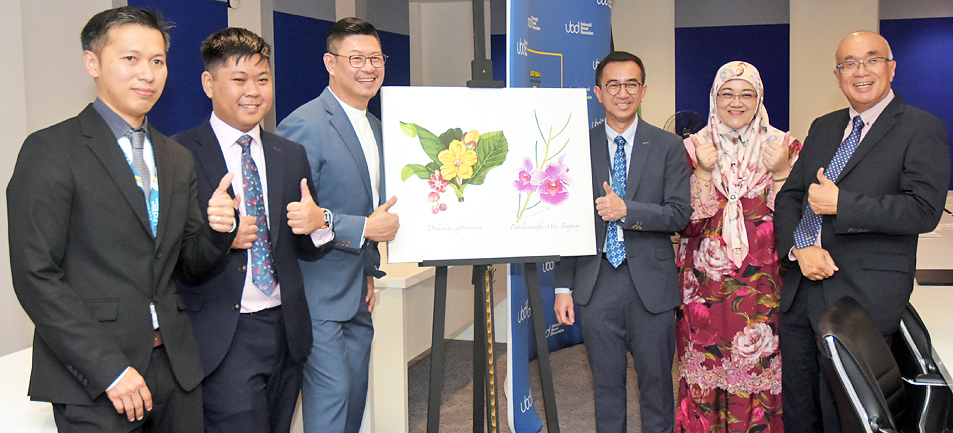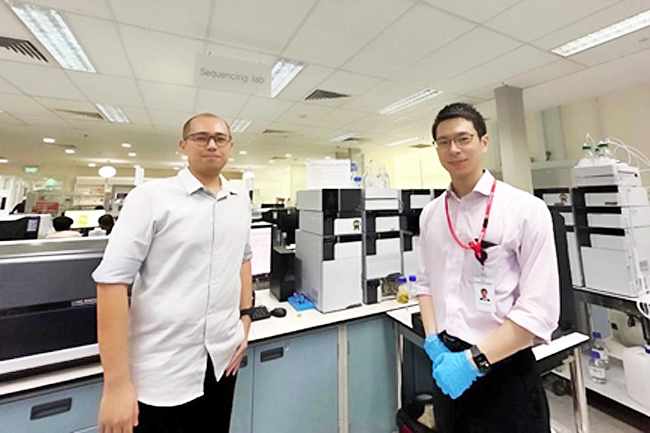Researchers from the Institute for Biodiversity and Environmental Research (IBER) and the Universiti Brunei Darussalam (UBD) Faculty of Science, and SingHealth Duke-NUS Institute of Biodiversity Medicine (BD-MED), in a world’s first, fully mapped the genome of the Sultanate’s national flower bunga simpur (dillenia suffruticosa) and found potential therapeutic properties, encompassing anti-cancer capabilities.
The findings were shared during a press conference yesterday on the bunga simpur genome project chaired by UBD Vice-Chancellor Dr Hazri bin Haji Kifle with the project’s researchers.
“The findings were presented to His Majesty Sultan Haji Hassanal Bolkiah Mu’izzaddin Waddaulah ibni Al-Marhum Sultan Haji Omar ‘Ali Saifuddien Sa’adul Khairi Waddien, Sultan and Yang Di-Pertuan of Brunei Darussalam, Chancellor, Universiti Brunei Darussalam during the 35th Universiti Brunei Darussalam convocation ceremony on Monday,” Dr Hazri said.
UBD Principal Investigator for the project Dr Hajah Norhayati binti Haji Ahmad from IBER said, “Simpur bini stands out in Brunei’s secondary forests for its large penni-veined leaves, bright yellow flowers, and pink star-shaped ‘fruits’. This species is significant in Bruneian culture and the regional forest ecosystem.
“Traditionally, the plant’s robust leaves have been used to ferment culinary staples, such as rice to create tapai and soybeans to create tempeh.
“Beyond their culinary uses, the leaves have long been a natural remedy in the local populace, for healing minor cuts, reducing inflammation, and providing relief from itching.”
She added, “Researchers extracted DNA from bunga simpur and using advanced genomic sequencing technologies and data analytics, the complete DNA map, or genome, was pieced together and found to contain 34,195 genes – 1.5 times more than the human genome.“




The research has unveiled some potential medical and commercialisation avenues, as researchers found that the flower’s genome could potentially produce organic compounds with therapeutic properties.
Chemical profiling of the flower’s extracts using mass spectrometry found it abundant in terpenoid and flavonoid compounds, some of which have shown promising anti-cancer properties on cancer cell lines in other studies. Beyond its promising anti-cancer properties, the flower’s therapeutic compounds also have anti-inflammatory and anti-microbial features according to evidence from previous literature.
Dr Hajah Norhayati said, “With further research, these agents can be harnessed to develop potential wound care products, cosmeceuticals, and nutraceutical formulations. Such innovations could provide preventive health benefits and pathways. The anti-cancer results also encourage comprehensive research.”
She added, “The bunga simpur genome project is part of the initiative to investigate the many species of Brunei’s unique flora in IBER’s future research.”
“The research team plans to further the study and evaluate the therapeutic compounds found in bunga simpur.”
IBER UBD and BD-MED extended their gratitude to the Government of His Majesty and presented artworks of the national flowers of Brunei and Singapore as a gift to His Majesty during the 35th UBD Convocation Ceremony.
BD-MED Director Professor Teh Bin Tean revealed that upcoming biodiversity studies are on durian and ginger.
“Interestingly, durian has even more genes than bunga simpur. We are very fortunate to have this partnership with UBD. We are contributing to biodiversity conservation especially in view of climate change.”
He added, “We know that a lot of plants and flowers have been used traditionally for centuries by our ancestors, who had no technology or scientific methodology. Many remedies were folklore or stories passed down from generation to generation.
“Now, with the advancement of technology and science, we can look into the scientific basis for their use. For example for bunga simpur, we will need to carry out animal and human studies and see its effects. In the next 10 to 20 years, I am confident there will be more discoveries from our rainforests.”
The findings are set to be publishing in an international journal soon. – James Kon





